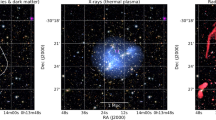Abstract
A primary cosmic ray particle energy specturm of Galactic origin with a sharp cut-off at an energy per nucleon of 3 × 104 GeV for protons and 5 × 104 GeV for heavier particles and extending only upto energies ∼ 1015 eV is deduced in part from the observed cosmic ray phenomena at the highest energies. It appears that the cut off is not due to the magnetic rigidity of the particles in the Galaxy but due to a cut off in or near the sources themselves. In particular, it is pointed out that Fermi type of acceleration is unlikely to be important in the production of energetic cosmic ray particles in the Galaxy. A pedestal in the energy spectrum from an extra Galactic component upto a maximum energy per nucleon ∼ 107 GeV with an upper limit of total energies ∼ 1018 eV has been added.
Similar content being viewed by others
References
Subramanian, A.Tata Institute of Fundamental Research Note, T.I.F.R., A.S.-2-72, April, 1972 (unpublished).
Grigorov, N. L., Gubin, Yu. V., Rapoport, I. D., Savenke, I. A., Yakovlev, B. M., Akimov, V. V. and Nesterov, V. E.12th International Conference on Cosmic Rays, Hobart, 1971,5, 1746.
Akimov, V. V., Grigorov, N. L., Nesterov, V. E., Rapoport, I. D., Savenko, I. A., Skuridin, G. A. and Titenkov, A. F.Proc. of the 11th Int. Conf. on Cosmic Rays, Budapest, 1969; published inActa Physica Academiae Scientiarum Hungaricae, 1970,29, Suppl. 1, 517.
Grigorov, N. L., Rapoport, I. D., Savenko, I. A., Nesterov, V. E. and Prokhin, V. L.12th Int. Conf. on Cosmic Rays, Hobart, 1971,5, 1760.
Ashley, G. K., Keuffel, J. W. and Larson, M. O.Ibid., 1971,4, 1359.
Ginzburg, V. L. and Syrovatsky, S. I.Suppl. Progr. Th. Phys. 1961,20, 1.
Hayakawa, S., Nishimura, J., Obayashi, H. and Sato, H.Ibid, 1964,30, 86.
—Progr. Th. Phys., 1956,15, 101.
Colgate, S. A. and Johnson, M. H.Phys. Rev. Letters, 1960,5, 235.
Peters, B.Cosmic Ray Physics, Edited by J. G. Wilson (North Holland Publishing Co.), 1952, p. 193;Nuovo Cimento, 1961,22, 800.
Aizu, H., Ito, K. and Koshiba, M.Suppl. Progr. Theor. Phys., 1964,30, 134.
Wdowczyk, J. and Wolfendale, A. W.Nature: Physical Science, 1972,236, 29.
Fujimoto, Y., Hasegawa, H. and Taketani, M.Suppl. Progr. Th. Phys., 1964,30, 32.
Greisen, K.Proc. of the 9th Int. Conf. on Cosmic Rays, London, 1965,2, 609.
The reason for limiting the primary cosmic ray spectrum to ∼1018 eV only is because evidence from air showers beyond this limit is not yet conclusive,see Subramanian, A., preprint T.I.F.R.-A.S.-1-72, April, 1972 (Current Science. 1972,41, 629).
Author information
Authors and Affiliations
Additional information
Communicated by Dr. B. V. Sreekantan,f.a.sc.
Rights and permissions
About this article
Cite this article
Subramanian, A. A possible cosmic ray primary particle energy spectrum above 104 GeV and its astrophysical implications. Proc. Indian Acad. Sci. 76, 121–128 (1972). https://doi.org/10.1007/BF03049440
Received:
Issue Date:
DOI: https://doi.org/10.1007/BF03049440



